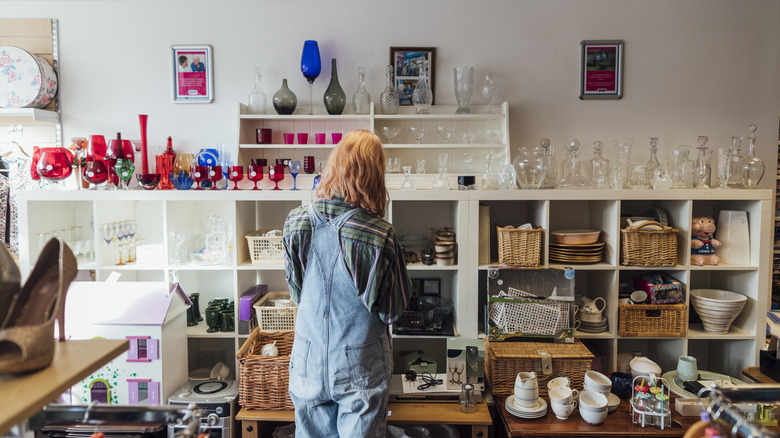The Green Flag That May Mean A Thrifted Item Is Worth Buying
These days, many people know that thrifting is about more than just saving a few bucks. From the environmental benefits of buying secondhand rather than new to the excitement of finding something completely unique, there are plenty of reasons to visit a thrift store. You may have even heard stories of people snagging some incredible finds at thrift stores, such as designer-brand items in good condition or handmade antique furniture that you simply cannot find today. But when there isn't a clear tag or label on an item, it can be difficult to determine its worth and whether you want to make the purchase. Luckily, there are all kinds of tips on how to spot valuable, high-end items at thrift stores without extensive research or an official appraisal.
One feature to look for as an indicator of a high-quality, well-made product is its weight. Generally, the idea is that heavier objects are made from materials of higher quality and are better worth an investment than lightweight items. While it may sound like a cheap trick, there is some reasoning behind this idea. From clothing to furniture and beyond, if an object has some heaviness to it when you pick it up, it may be a result of better construction and materials that are denser, sturdier, and consequently, longer-lasting. However, there are some exceptions to the rule, too. Knowing exactly which objects to consider the weight of can help you make smart purchases and avoid wasting money on pieces that will quickly deteriorate.
Does weight indicate quality?
Thrift stores are full of a wide variety of objects, and spotting something gorgeous but eventually being disappointed in its quality, construction, or longevity can definitely happen. Whether you find a vase that turns out to be plastic instead of glass or a nightstand made of MDF rather than solid wood, it helps to keep the idea of weight in mind before you take the items home. Definitely pick up or try to pick up any furniture before you buy.
Solid wood items will have noticeable weight to them. High-quality upholstered furniture, cushions, and more will also all have a bit more heft to them due to the use of down rather than cheap foam inside. For decorative pieces, including wall decor, real glass is heavier than plastic, and glass is typically thought to be of higher quality than plastic, though it can depend on the item.
This quality-checking tip can even work for clothing and accessories. Often, heavier fabrics are more durable and may have denser weaves than lightweight items, so they will better retain their nice shapes over time. When holding items made from wool, linen, silk, and other natural fibers, getting an idea of the density from weight is especially helpful. As for jewelry, real gold and silver tend to weigh more than cheaper, similar metals.
Overall, even briefly holding an item can help you find the real deal. Of course, there are times when choosing the heaviest object doesn't guarantee the highest quality, so it's important to know how to use this tip when shopping.
How to use the weight trick to shop for valuable items
While you're in the store inspecting all of the valuable vintage trinkets you should always look for at thrift stores and estate sales, try to pick up any items you're interested in. This gives you a chance to look for any visible damage and to assess the construction. Just holding the item should help you determine if it has a solid feel to it. You don't need a scale to get an exact measurement, but comparing the weight of your desired object to a few similar items nearby can help you establish a baseline and see how the one you're interested in stacks up.
While a more substantial-feeling object is often made from durable, strong materials, the association between weight and quality can also merely be the result of your brain playing tricks. Psychologically, people perceive physically heavier items to be nicer than lighter ones. Weight can be an important green flag, but it's vital to truly assess an item before buying it. You should also check for brands, tags, and the general condition of the item so you don't accidentally skip a lightweight silk blouse or grab a poorly constructed table just because it's hard to lift. It's not ideal if it's cracked, not your style, or unstable on the floor.
There are plenty of tips for ensuring you're buying furniture that's built to last beyond trying to lift it. Plus, lightweight items may just be new, not necessarily substandard, as a result of more recent manufacturing.


